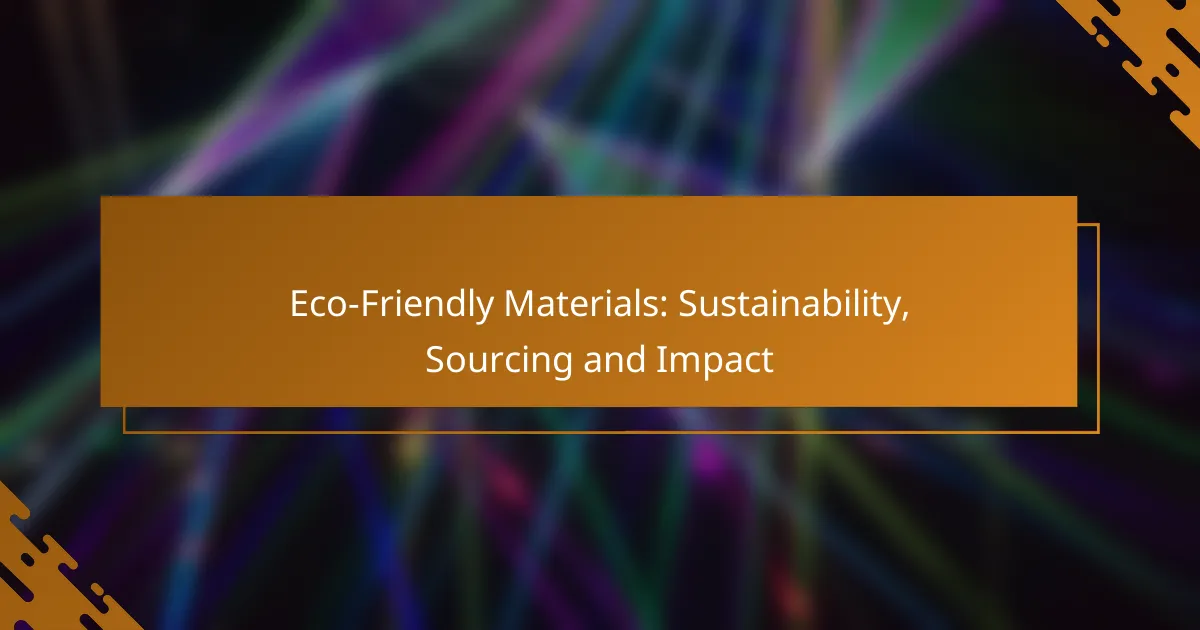Eco-friendly materials are designed to minimize environmental impact throughout their entire lifecycle, from sourcing to disposal. By promoting sustainability through responsible sourcing and efficient resource use, these materials contribute to a healthier planet. They often originate from renewable sources and are intended to be biodegradable or recyclable, making them a vital choice for eco-conscious consumers and businesses alike.

What are eco-friendly materials?
Eco-friendly materials are substances that have a minimal negative impact on the environment throughout their lifecycle. They are sourced, produced, and disposed of in ways that promote sustainability and reduce ecological harm.
Biodegradable plastics
Biodegradable plastics are designed to break down more quickly than traditional plastics, often within a few months to a few years, depending on environmental conditions. They are made from natural materials like corn starch or sugarcane, making them a more sustainable option.
When choosing biodegradable plastics, consider their compostability and whether they meet standards such as ASTM D6400 in the U.S. or EN 13432 in Europe. Proper disposal in composting facilities is crucial for them to decompose effectively.
Recycled metals
Recycled metals, such as aluminum and steel, are repurposed from scrap materials, reducing the need for virgin resources and minimizing energy consumption. Recycling metals can save up to 95% of the energy required to produce new metals from raw materials.
When sourcing recycled metals, look for certifications that verify the percentage of recycled content. This ensures that you are contributing to a circular economy and reducing environmental impact.
Organic cotton
Organic cotton is grown without synthetic pesticides or fertilizers, promoting healthier ecosystems and reducing water usage. It is often certified by organizations like the Global Organic Textile Standard (GOTS), ensuring adherence to strict environmental and social criteria.
When purchasing organic cotton products, check for labels that confirm organic certification. This guarantees that the cotton was produced sustainably and supports fair labor practices.
Bamboo fibers
Bamboo fibers are derived from the fast-growing bamboo plant, which requires minimal water and no pesticides to thrive. This makes bamboo a highly sustainable material for textiles, as it can be harvested without harming the plant.
However, the processing of bamboo into fabric can involve chemicals, so look for brands that use eco-friendly methods. Certifications like OEKO-TEX can indicate safer production practices.
Hemp textiles
Hemp textiles are made from the fibers of the hemp plant, known for their durability and low environmental impact. Hemp grows quickly and requires less water and fewer chemicals compared to conventional crops like cotton.
When selecting hemp products, consider those that are certified organic to ensure sustainable farming practices. Hemp textiles can be a great choice for eco-conscious consumers looking for long-lasting materials.

How do eco-friendly materials promote sustainability?
Eco-friendly materials enhance sustainability by reducing environmental impact through responsible sourcing, efficient resource use, and waste minimization. These materials often come from renewable sources and are designed to be biodegradable or recyclable, contributing to a healthier planet.
Reduced carbon footprint
Using eco-friendly materials significantly lowers the carbon footprint associated with production and transportation. For instance, materials like bamboo and hemp grow quickly and require fewer resources compared to traditional options like plastic or synthetic fibers.
When sourcing locally, businesses can further decrease emissions related to transportation. Opting for products made from recycled materials can also cut down on the energy needed for manufacturing, leading to a smaller overall carbon footprint.
Conservation of resources
Eco-friendly materials promote the conservation of natural resources by utilizing renewable inputs. For example, sustainably sourced wood or organic cotton minimizes the depletion of forests and soil, respectively.
Additionally, many eco-friendly products are designed to be durable, reducing the need for frequent replacements. This longevity helps preserve resources over time, as fewer materials are needed to meet consumer demand.
Minimized waste production
The use of eco-friendly materials often leads to minimized waste production during both manufacturing and disposal. Many of these materials are designed to be recyclable or compostable, which helps divert waste from landfills.
Companies can implement practices like closed-loop systems, where waste from one process becomes input for another. This approach not only reduces waste but also encourages a circular economy, where resources are continuously reused.

Where to source eco-friendly materials in the USA?
In the USA, eco-friendly materials can be sourced from various local suppliers, online marketplaces, and sustainable brands. These options provide a range of choices for individuals and businesses looking to make environmentally conscious decisions.
Local suppliers
Local suppliers often offer eco-friendly materials that are sourced sustainably and produced with minimal environmental impact. Visiting farmers’ markets, craft fairs, or specialty stores can reveal options like organic textiles, reclaimed wood, and biodegradable packaging.
When selecting local suppliers, consider their certifications, such as USDA Organic or Forest Stewardship Council (FSC) labels, which indicate adherence to sustainable practices. Building relationships with these suppliers can also lead to better pricing and unique product offerings.
Online marketplaces
Online marketplaces provide a convenient way to access a wide variety of eco-friendly materials from different regions. Websites like Etsy, Amazon, and specialized eco-focused platforms allow users to filter products based on sustainability criteria.
When shopping online, check for product descriptions that highlight eco-friendly attributes, such as recycled content or low carbon footprints. Reading customer reviews can also help gauge the quality and sustainability of the materials before making a purchase.
Sustainable brands
Sustainable brands focus on creating eco-friendly materials while prioritizing ethical sourcing and production practices. Companies like Patagonia, Eileen Fisher, and Seventh Generation are known for their commitment to sustainability and transparency in their supply chains.
Choosing products from these brands often ensures that materials are made from organic, recycled, or responsibly sourced components. Look for certifications like Global Organic Textile Standard (GOTS) or Cradle to Cradle, which further validate a brand’s sustainability claims.

What are the benefits of using eco-friendly materials?
Using eco-friendly materials offers numerous advantages, including improved health, enhanced brand reputation, and potential long-term cost savings. These materials contribute to sustainability while meeting consumer demand for environmentally responsible products.
Healthier living environments
Eco-friendly materials often contain fewer harmful chemicals, reducing indoor air pollution and promoting healthier living spaces. For instance, natural paints and finishes can minimize volatile organic compounds (VOCs), which are linked to respiratory issues and other health problems.
Choosing materials like bamboo flooring or organic textiles can also lead to better overall well-being. These options are not only sustainable but also contribute to a more comfortable and safe environment for occupants.
Enhanced brand reputation
Utilizing eco-friendly materials can significantly boost a brand’s reputation among consumers who prioritize sustainability. Companies that adopt green practices often attract environmentally conscious customers, leading to increased loyalty and market share.
Moreover, showcasing a commitment to sustainability can differentiate a brand in a crowded marketplace. This can be particularly effective in industries such as fashion, construction, and food, where consumers are increasingly scrutinizing sourcing and production methods.
Long-term cost savings
While eco-friendly materials may have a higher upfront cost, they can lead to significant savings over time. For example, energy-efficient materials can reduce utility bills, while durable products often require less frequent replacement.
Investing in sustainable options can also mitigate risks associated with regulatory changes and shifting consumer preferences. Companies that proactively adopt eco-friendly practices may avoid potential costs related to compliance and reputational damage in the future.

How to choose eco-friendly materials for your products?
Choosing eco-friendly materials involves assessing their sustainability, sourcing practices, and overall environmental impact. Prioritize materials that are renewable, recyclable, or biodegradable, and consider their life cycle from production to disposal.
Consider the source of materials
When selecting eco-friendly materials, investigate their origins. Look for suppliers who practice sustainable harvesting and have certifications like FSC (Forest Stewardship Council) for wood products or GOTS (Global Organic Textile Standard) for textiles. This ensures that the materials are sourced responsibly, minimizing harm to ecosystems.
Evaluate the material’s life cycle
Assess the entire life cycle of the material, from extraction to disposal. Eco-friendly materials should have a lower carbon footprint and be designed for reuse or recycling. For example, materials like bamboo grow quickly and require fewer resources, making them a sustainable choice compared to traditional hardwoods.
Check for certifications and standards
Certifications can guide your selection of eco-friendly materials. Look for labels such as Energy Star, LEED, or Cradle to Cradle, which indicate adherence to environmental standards. These certifications help ensure that the materials meet specific sustainability criteria, providing reassurance to consumers.
Consider the end-of-life options
Think about how the materials will be disposed of or reused at the end of their life cycle. Choose materials that can be easily recycled or composted to reduce landfill waste. For instance, biodegradable plastics can break down naturally, unlike conventional plastics that persist in the environment for decades.

